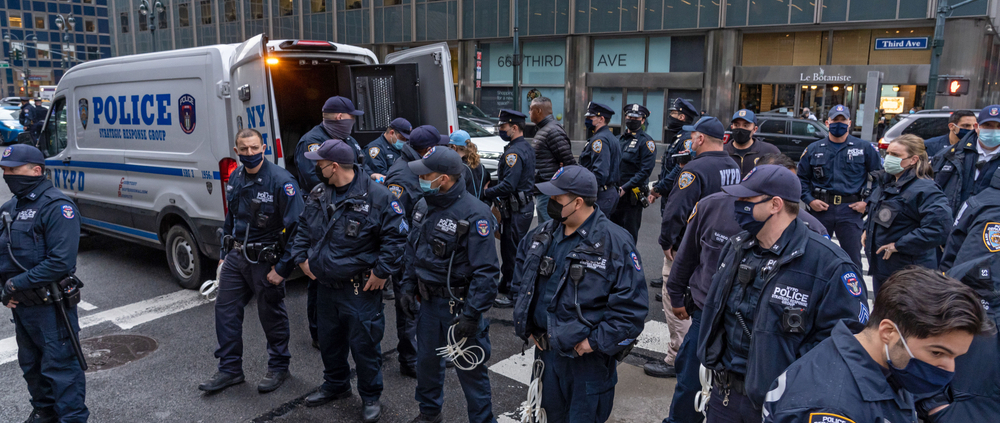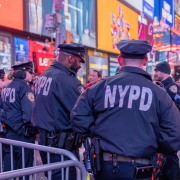A Call to Abolish the 48-Hour Rule: Enhancing Accountability in Policing
By Esther Claudette Gittens | Editorial Credit: Ron Adar / shutterstock.com
This article explores the process of eliminating the 48-hour rule
The 48-hour rule in the New York Police Department (NYPD) has long been a subject of controversy and debate. This rule, which provides officers a 48-hour window before they are required to answer questions following incidents of potential misconduct, has been criticized for impeding timely investigations and undermining police accountability. Eliminating the 48-hour rule is a necessary step towards fostering a culture of accountability within the NYPD, addressing community concerns, and aligning with best practices in policing. Read more at www.askthelawyer.us. To read the complete analysis in our publication, click here, and on our civil rights blog, click here.
This analysis explores the process of eliminating the 48-hour rule, the challenges involved, and the strategies needed to overcome these barriers. By examining successful case studies from other cities and considering the potential impacts of such a policy change, this analysis will provide a roadmap for New York City to lead the way in creating a more equitable and just law enforcement system.
Section 2: Understanding the 48-Hour Rule and Its Implications
The 48-hour rule grants NYPD officers a period of 48 hours before they are required to provide a statement following incidents involving possible misconduct, such as shootings, use of excessive force, or in-custody deaths. This rule is rooted in labor agreements between the city and police unions, primarily the Patrolmen’s Benevolent Association (PBA), and is intended to provide officers with time to secure legal representation and prepare for questioning. While proponents argue that the rule protects officers’ rights and ensures due process, critics assert that it undermines accountability by allowing officers time to align their stories or avoid immediate scrutiny.
2.1 Historical Background and Current Status
The 48-hour rule has been in place for decades, originating from labor negotiations that sought to balance the need for fair treatment of officers with the demands of effective policing. However, the rule’s application has increasingly come under fire in the wake of high-profile cases of police misconduct, such as the deaths of Amadou Diallo, Sean Bell, and Eric Garner. These incidents highlighted the need for swift and unbiased investigations, which many believe the 48-hour rule obstructs.
As it stands today, the 48-hour rule remains a part of the NYPD’s protocols, upheld by strong police union support and legal protections under collective bargaining agreements. Despite growing calls for reform from community groups, civil rights organizations, and some city officials, the rule continues to be a barrier to full accountability and transparency in police practices.
2.2 Implications for Police Accountability and Public Trust
The existence of the 48-hour rule has significant implications for police accountability and public trust:
- Delayed Investigations: By delaying the questioning of officers, the rule can result in the loss of critical evidence, fading memories, and the potential for coordinated narratives, all of which undermine the integrity of investigations.
- Perception of Impunity: The rule fosters a perception that police officers operate under a different set of rules than civilians, contributing to a sense of impunity and eroding public confidence in law enforcement.
- Barrier to Transparency: The rule limits the transparency of investigations, making it difficult for oversight bodies, such as the Civilian Complaint Review Board (CCRB), to conduct thorough and timely reviews of incidents involving potential misconduct.
Given these implications, eliminating the 48-hour rule is essential for building a more accountable and transparent police force that can effectively serve and protect all New Yorkers.
Section 3: Challenges in Eliminating the 48-Hour Rule
Eliminating the 48-hour rule is not a simple task and presents several challenges that must be navigated carefully:
3.1 Legal and Contractual Barriers
The 48-hour rule is enshrined in the collective bargaining agreements between the city and police unions. These agreements are legally binding and provide significant protections for officers, making any changes to the rule a complex legal issue. To eliminate the rule, the city would need to renegotiate these agreements, which could be a lengthy and contentious process.
Moreover, any changes to the rule could face legal challenges from police unions, who may argue that such changes violate the terms of their contracts or infringe upon officers’ rights. Navigating these legal and contractual barriers will require a robust legal strategy and a willingness to engage in prolonged negotiations.
3.2 Political Resistance and Influence of Police Unions
Police unions in New York City, particularly the PBA, wield significant political influence. They have a history of mobilizing their membership and leveraging public safety concerns to push back against reforms perceived as undermining police authority or protections. This influence extends to elected officials, many of whom may be reluctant to support changes to the 48-hour rule due to fears of being labeled “anti-police” or jeopardizing their political careers.
Successfully eliminating the rule will require building broad-based political support and countering the narrative that such reforms are anti-police. It will also necessitate addressing concerns about potential impacts on public safety and officer morale.
3.3 Potential Pushback from Law Enforcement and Public Safety Concerns
Law enforcement officials may argue that eliminating the 48-hour rule could lead to rushed investigations, coerced testimonies, or unfair treatment of officers involved in high-stress situations. Additionally, there may be concerns that such a change could negatively impact public safety by demoralizing officers or leading to increased hesitancy in their decision-making.
Addressing these concerns will be critical in garnering support for eliminating the rule. This includes demonstrating that eliminating the rule will not compromise due process or officer rights and that it can lead to a more just and effective policing system.
Section 4: Strategies for Eliminating the 48-Hour Rule
To successfully eliminate the 48-hour rule, a multi-faceted strategy must be employed, involving legislative, negotiation, and advocacy efforts.
4.1 Legislative Approaches at the City and State Levels
One of the most effective ways to eliminate the 48-hour rule is through legislative action at the city and state levels. This could involve:
- City Council Legislation: The New York City Council has the authority to introduce and pass local laws that can impact police practices. A bill could be introduced to prohibit the use of the 48-hour rule or to mandate immediate questioning of officers involved in critical incidents.
- State Legislation: Given the legal complexities involved in altering collective bargaining agreements, state-level legislation could provide a broader framework for police accountability reforms that preempt local union contracts. For example, the New York State Legislature could pass a law that sets statewide standards for police conduct investigations, effectively overriding local rules like the 48-hour provision.
Legislative approaches will require strong advocacy and lobbying efforts to build support among lawmakers, as well as careful drafting to ensure legal defensibility and effectiveness.
4.2 Negotiating with Police Unions to Amend Collective Bargaining Agreements
Another approach is to directly negotiate with police unions to amend existing collective bargaining agreements to eliminate the 48-hour rule. This approach would involve:
- Good Faith Negotiations: Engaging in negotiations with police unions in good faith, offering concessions in other areas (such as benefits or working conditions) in exchange for eliminating the 48-hour rule.
- Leveraging Public Pressure: Utilizing public support for police accountability reforms to apply pressure on unions to come to the negotiating table. This could involve community rallies, media campaigns, and public statements from influential figures and organizations.
- Incorporating External Mediation: Bringing in external mediators with expertise in labor relations and police reform to facilitate negotiations and help both sides reach a fair agreement.
While challenging, negotiating with police unions could provide a pathway to reform that avoids lengthy legal battles and builds consensus.
4.3 Advocacy and Community Engagement to Build Public Support
Building a strong base of public support is essential for eliminating the 48-hour rule. This involves:
- Grassroots Organizing: Mobilizing community organizations, civil rights groups, and advocacy networks to raise awareness about the issue and generate public pressure for reform.
- Public Education Campaigns: Launching public education campaigns that explain the detrimental effects of the 48-hour rule on accountability and justice, using data, case studies, and personal testimonies to make the case for change.
- Engaging Key Stakeholders: Engaging key stakeholders, such as local elected officials, community leaders, legal experts, and law enforcement professionals, to build a broad coalition in support of eliminating the rule.
By demonstrating widespread public support and making the moral and practical case for reform, advocates can create a conducive environment for change.
Section 5: Case Studies of Other Cities
Examining the experiences of other cities that have eliminated similar rules can provide valuable insights and lessons for New York City.
5.1 Examination of Cities that Have Eliminated Similar Rules
Several cities across the United States have successfully eliminated rules similar to the NYPD’s 48-hour provision, opting for more immediate and transparent investigative processes. Notable examples include:
- Los Angeles, California: The Los Angeles Police Department (LAPD) eliminated a similar “cooling-off period” for officers involved in shootings and other critical incidents. This change was part of broader police reform efforts aimed at increasing transparency and accountability.
- Chicago, Illinois: Chicago’s Police Accountability Task Force recommended eliminating the 24-hour rule that allowed officers to delay giving statements after shooting incidents. The city implemented reforms to ensure that officers are promptly interviewed, improving the investigative process’s timeliness and integrity.
- Seattle, Washington: Seattle has implemented comprehensive police reforms, including policies that require immediate separation and questioning of officers involved in use-of-force incidents. These changes were part of a consent decree with the U.S. Department of Justice, aimed at reducing excessive force and bias in policing.
5.2 Lessons Learned from Their Processes and Outcomes
The experiences of these cities offer several key lessons:
- Importance of Community Involvement: Engaging the community and building public support is crucial for sustaining reform efforts and countering resistance from police unions and other stakeholders.
- Need for Strong Oversight Mechanisms: Reforms must be accompanied by strong oversight mechanisms, such as independent review boards, to ensure that changes are effectively implemented and maintained.
- Balancing Officer Rights and Accountability: Successful reforms balance protecting officers’ rights with the need for timely and transparent investigations, demonstrating that it is possible to achieve both goals.
5.3 Potential Pitfalls and Best Practices for New York City
- Pitfalls to Avoid: Common pitfalls include insufficient engagement with police unions, lack of clarity in new policies, and inadequate enforcement of reforms. New York City must learn from these challenges to avoid similar mistakes.
- Best Practices to Adopt: Best practices include comprehensive training for officers on new protocols, robust community oversight, and continuous monitoring and evaluation to assess the effectiveness of reforms.
Section 6: Impacts of Eliminating the 48-Hour Rule
Eliminating the 48-hour rule will have several significant impacts on police accountability, community relations, and the overall culture within the NYPD.
6.1 Effects on Police Accountability and Misconduct Investigations
- Improved Investigative Integrity: Immediate questioning of officers involved in misconduct will enhance the integrity and credibility of investigations, reducing the potential for narrative alignment and evidence loss.
- Increased Transparency: Eliminating the rule will increase transparency in the investigative process, making it easier for oversight bodies like the CCRB to conduct thorough and unbiased reviews.
- Strengthened Accountability Measures: With more timely and accurate investigations, there will be greater accountability for officers who engage in misconduct, leading to more appropriate disciplinary actions and deterrence.
6.2 Enhancing Public Trust and Improving Community-Police Relations
- Restoring Public Confidence: Removing the 48-hour rule will help restore public confidence in the NYPD by demonstrating a commitment to fairness, accountability, and equal treatment under the law.
- Building Bridges with Communities: Eliminating the rule is a step towards repairing fractured relationships between the NYPD and the communities it serves, particularly communities of color that have been disproportionately affected by aggressive policing tactics.
6.3 Long-Term Cultural Changes Within the NYPD
- Fostering a Culture of Accountability: Eliminating the 48-hour rule will contribute to a broader cultural shift within the NYPD towards prioritizing accountability and transparency, which is essential for long-term reform.
- Promoting Ethical Policing Practices: By aligning policies with best practices, the NYPD can promote a culture of ethical policing that values integrity, community engagement, and the protection of civil rights.
Section 7: Conclusion
Eliminating the 48-hour rule within the NYPD is a necessary and critical step toward fostering a culture of accountability and transparency in New York City’s law enforcement. By navigating legal, political, and practical challenges through legislative action, negotiations with police unions, and robust advocacy efforts, the city can successfully eliminate this rule and set a new standard for police practices.
7.1 Summary of Key Arguments and Recommendations
- Key Arguments: The 48-hour rule impedes timely investigations, fosters a perception of impunity, and erodes public trust. Eliminating it is essential for building an accountable police force.
- Recommendations: Adopt legislative and negotiation strategies, build strong public support, and learn from other cities to successfully eliminate the rule.
7.2 The Broader Vision for an Accountable and Equitable NYPD
By eliminating the 48-hour rule and embracing comprehensive reforms, New York City has the opportunity to lead the way in creating an accountable and equitable NYPD that serves all communities with fairness and integrity.
7.3 Final Thoughts on Policy Changes and Next Steps
The journey toward eliminating the 48-hour rule is complex but necessary. With sustained effort, strategic planning, and community engagement, New York City can pave the way for meaningful and lasting change in policing practices, setting an example for cities across the nation.










Leave a Reply
Want to join the discussion?Feel free to contribute!